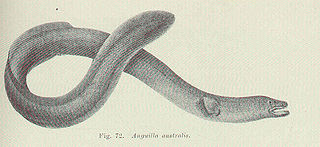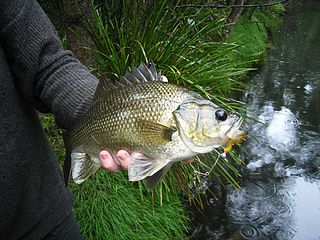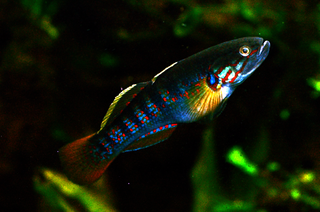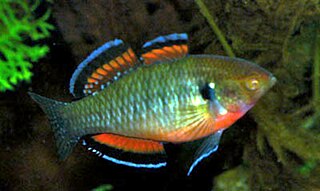
Plankton are the diverse collection of organisms found in water that are unable to propel themselves against a current. The individual organisms constituting plankton are called plankters. In the ocean, they provide a crucial source of food to many small and large aquatic organisms, such as bivalves, fish, and baleen whales.

The short-finned eel, also known as the shortfin eel, is one of the 15 species of eel in the family Anguillidae. It is native to the lakes, dams and coastal rivers of south-eastern Australia, New Zealand, and much of the South Pacific, including New Caledonia, Norfolk Island, Lord Howe Island, Tahiti, and Fiji.

The Australian bass is a small- to medium-sized species of primarily freshwater fish found in coastal rivers and streams along the east coast of Australia. A member of the genus Macquaria from the family Percichthyidae, the Australian bass is an important member of the native fish assemblages found in east coast river systems. It is a native predatory fish and an extremely popular game fish species among anglers. The species was simply called perch in most coastal rivers where it was caught until the 1960s, when the name "Australian bass" started to gain popularity.

Eleotridae is a family of fish commonly known as sleeper gobies, with about 34 genera and 180 species. Most species are found in the tropical Indo-Pacific region, but there are also species in subtropical and temperate regions, warmer parts of the Americas and near the Atlantic coast in Africa. While many eleotrids pass through a planktonic stage in the sea and some spend their entire lives in the sea; as adults, the majority live in freshwater streams and brackish water. One of its genera, Caecieleotris, is troglobitic. They are especially important as predators in the freshwater stream ecosystems on oceanic islands such as New Zealand and Hawaii that otherwise lack the predatory fish families typical of nearby continents, such as catfish. Anatomically, they are similar to the gobies (Gobiidae), though unlike the majority of gobies, they do not have a pelvic sucker.

The New Zealand smelt, also known as the New Zealand common smelt, New Zealand cucumber fish, or silveries is a smelt of the family Retropinnidae, found only in New Zealand at shallow depths in estuaries and rivers. Their length is between 8 and 13 cm.

The flathead grey mullet is an important food fish species in the mullet family Mugilidae. It is found in coastal tropical and subtropical waters worldwide. Its length is typically 30 to 75 centimetres. It is known with numerous English names, including the flathead mullet, striped mullet, black mullet, bully mullet, common mullet, grey mullet, sea mullet and mullet, among others.

The New Zealand eagle ray or Australian eagle ray is an eagle ray of the family Myliobatidae, found in bays, estuaries, and near rocky reefs around New Zealand and southern Australia on the inner continental shelf. It is a common species and the International Union for Conservation of Nature has assessed its conservation status as being of "least concern".

Asterias amurensis, also known as the Northern Pacific seastar and Japanese common starfish, is a seastar found in shallow seas and estuaries, native to the coasts of northern China, Korea, far eastern Russia, Japan, Alaska, the Aleutian Islands and British Columbia in Canada. Two forms are recognised: the nominate and formarobusta from the Strait of Tartary. It mostly preys on large bivalve molluscs, and it is mostly preyed on by other species of starfish. Population booms in Japan can affect the harvest of mariculture operations and are costly to combat.

The giant trevally, also known as the lowly trevally, barrier trevally, ronin jack, giant kingfish, or ulua, is a species of large marine fish classified in the jack family, Carangidae. The giant trevally is distributed throughout the tropical waters of the Indo-Pacific region, with a range stretching from South Africa in the west to Hawaii in the east, including Japan in the north and Australia in the south. Two were documented in the eastern tropical Pacific in the 2010s, but whether the species will become established there remains to be seen.

The Black bream, also commonly known as the southern black bream, southern bream and blue-nosed bream, is a species of anadromous ray-finned fish of the porgy family Sparidae. A deep-bodied fish, it is occasionally confused with other similar species that occur within its range, but is generally distinguished from these species by a lack of yellow ventral and anal fins. Southern black bream are endemic to the southern coasts of Australia from Shark Bay in Western Australia to Ulladulla, New South Wales, as well as Tasmania.

Acanthopagrus australis, the yellowfin bream, also known as sea bream, surf bream, silver bream or eastern black bream, is a species of marine and freshwater fish of the porgy family, Sparidae. It is a deep-bodied fish, occasionally confused with Acanthopagrus butcheri, but is generally distinguished by its yellowish ventral and anal fins. It is a popular target for recreational fishermen due to its capacity to fight well above its weight coupled with its table quality.

The peacock gudgeon or peacock goby is a tropical freshwater species of fish in the family Eleotridae that is endemic to the eastern part of Papua New Guinea. It can be found in schools hovering over the substrate in rivers and ponds. This species can reach a length of 7.5 cm (3.0 in). It is currently the only known member of its genus.

Coastal fish, also called inshore fish or neritic fish, inhabit the sea between the shoreline and the edge of the continental shelf. Since the continental shelf is usually less than 200 metres (660 ft) deep, it follows that pelagic coastal fish are generally epipelagic fish, inhabiting the sunlit epipelagic zone. Coastal fish can be contrasted with oceanic fish or offshore fish, which inhabit the deep seas beyond the continental shelves.

Gobio gobio, or the gudgeon, is a species of fish in the family Cyprinidae. This small fish is widely distributed in fresh-water streams and lakes across central and temperate Eurasia.

Gobiomorphus is a genus of fishes in the family Eleotridae native to New Zealand and Australia. They are typically small, benthic fishes with large, rounded fins and two dorsal fins. Many have an amphidromous lifecycle: the eggs are laid in fresh water, but the fry are dispersed to sea soon after hatching, and grow there for several months before returning to fresh water.

Mogurnda adspersa is a species of endangered gudgeon that is endemic to south-eastern mainland Australia. The fish is brown, although the shade becomes lighter near its abdomen. Spots of various colours occur on its sides. After a dramatic population decline in the late 20th century, the fish was thought to be locally extinct in several areas, but was rediscovered both in South Australia and Victoria in the 21st century. Various state governments, the Murray-Darling Basin Authority, and various volunteer organisations have been taking measures to increase the fish's numbers.

Hypseleotris compressa, the empire gudgeon, is a species of Gobiiform fish in the family Eleotridae endemic to Australia and south-central New Guinea.
The dwarf flathead gudgeon is a species of sleeper goby endemic to eastern Australia.

The flathead gudgeon is a species of fish in the family Eleotridae endemic to eastern Australia.

Gobiomorphus coxii, or Cox's gudgeon, is a species of sleeper goby in the family Eleotridae which is native to the upland rivers of south eastern Australia.




















